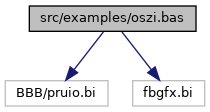Example: draw a graph of analog inputs. More...
#include "BBB/pruio.bi"#include "fbgfx.bi"
Go to the source code of this file.
Functions | |
| int | main () |
Variables | |
| VAR | S_W = 0 |
| The screen width. | |
| VAR | S_H = 0 |
| The srceen hight. | |
| VAR | BPP = 0 |
| The bits per plain number. | |
| VAR | full = fb.GFX_FULLSCREEN |
| Fullscreen or windowed mode. | |
| VAR | p = INSTR(COMMAND, "x") |
| The position of the 'x' character (if any). More... | |
| VAR | w = VALINT(COMMAND) |
| The required window width. | |
| VAR | h = VALINT(MID(COMMAND, p + 1)) |
| The required window hight. | |
| UInt32 | col [...] |
| The colors for the lines (= channels). More... | |
| UInt32 | last [...] |
| The previous data of the channels. More... | |
| VAR | io = NEW PruIo |
| Create a PruIo structure, wakeup subsystems. | |
| VAR | scale = S_H / 65520 |
| The factor to scale values. | |
| VAR | gap = 2 |
| The gap between x values. | |
| VAR | fg = RGB(0, 0, 0) |
| The foreground color. | |
| VAR | bg = RGB(250, 250, 250) |
| The background color. | |
| VAR | k = ASC(INKEY()) |
| The key code. | |
| VAR | m = .Conf->STEPENABLE |
| The step mask. | |
| VAR | neu = S_H - CUINT(.Value[i] * scale) |
| The new sample. | |
| VAR | j = i - 1 |
| The channel index. | |
Example: draw a graph of analog inputs.
This file contains an example on how to use libpruio to continuously draw a graph of the sampled data from the analog input lines. Find a functional description in section oszi.
Licence: GPLv3, Copyright 2014-2023 by Thomas{ doT ]Freiherr[ At ]gmx[ DoT }net
Compile by: fbc -w all oszi.bas
Definition in file oszi.bas.
| int main | ( | ) |
| UInt32 col[...] |
| UInt32 last[...] |